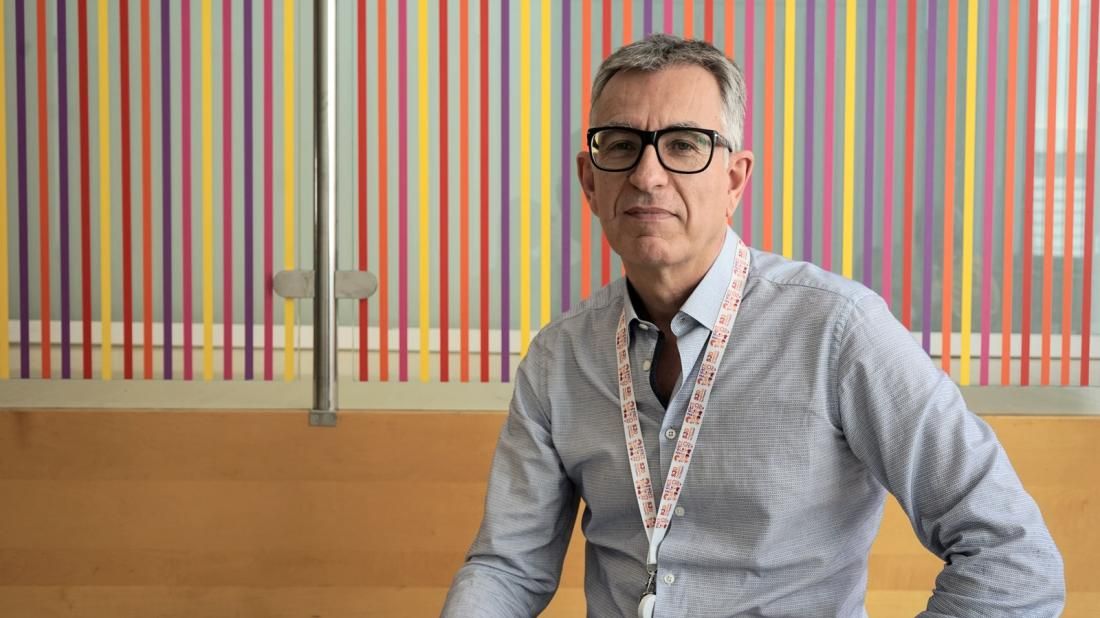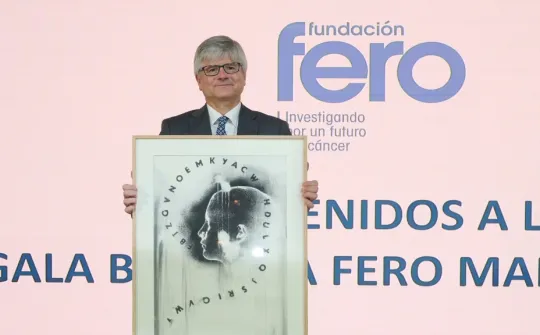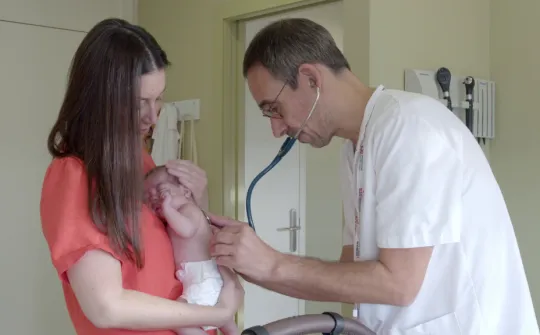
Interview with César Galo García Fontecha, Head of the Pediatric Traumatology and Orthopedics Department and recently elected president of the Spanish Paediatric Orthopaedic Society (SEOP)
Doctor César Galo García Fontecha invites us to his office for our interview, although he admits he is also quite comfortable in the Hospital cafeteria, where he can meet up with his colleagues. We interviewed the doctor a few days after his being named president of the SEOP—in recognition of his professional career and the opportunities he has had to contribute towards the development and promotion of this surgical specialism—to talk about how he got to where he is today.
Why did you specialise in Pediatric Traumatology and Orthopedics?
When I first specialised in traumatology, I opted for spinal surgery, and within that field, one of the most interesting subjects is childhood deformities. I started with scoliosis and then kept on progressing. In the year 2000, I was involved in the creation and organisation of a dedicated pediatric orthopedics department at the Vall d’Hebron Hospital. Orthopedic Surgery and Traumatology as a specialism has vastly different characteristics between the pediatric group and adults. Although children generally heal faster and better than adults, there are many complex, chronic diseases specific to infancy and adolescence that require specialised orthopedic treatment: hip, foot, hand, congenital diseases… there are several varieties of cases. Our main challenge is rooted in the complexity of pediatric traumatology.
And dealing with that complexity is your day-to-day job at the SJD Barcelona Children’s Hospital?
Exactly! We treat a high percentage of complex, chronic diseases which, within some units in our team, can easily make up to 50% of cases. Furthermore, we treat a large volume of patients, around 23,000 each year on average and our team is made up of around 20 highly-specialised professionals: not just in the field of pediatric orthopedics and traumatology, but also in specific diseases, about which they have a huge wealth of knowledge. For example, we treat cases of skeletal dysplasia, perform spine surgery on cases with associated neurological issues, and we handle reconstructive surgeries. Because of these efforts, we have been recognised by the ERN Bond as a leading healthcare facility for rare diseases.
In your role as a surgeon, you have researched and worked with patients with spina bifida, but you have also researched spine surgery and other diseases. Which specialism are you more focused on just now?
Fetal spina bifida surgery being part of my career path was quite incidental, but you could say that I was in the right place at the right time. As a spinal surgery specialist, years ago I suggested an animal-based line of research that focused on in-utero surgery to treat spina bifida. The aim was to simplify surgical techniques that were already being performed in the United States. This in-utero surgery worked very well, and in the hospital I worked in at the time, we managed to operate on 24 patients. Although the number of operated patients is not very high, the benefit to each of them has been extraordinary.
Pediatric traumatology is a very broad field, because it covers diseases affecting all parts of the musculoskeletal system. While I started out as a spine specialist, pediatric orthopedics covers problems with the knees, feet, hips, hands, etc. Throughout my career, I've been lucky enough to be able to specialise in practically all areas, at least a little bit. With this well-rounded experience, and with help from my team, we are able to offer a level of care that is tailored to the needs to every single patient.
How has pediatric traumatology changed since you first started?
Every year there are new or reworked techniques for treating all kinds of diseases. I can’t remember one specific point when things changed. It's been more like steady progress in the field. Orthopedic surgery improves through new technological advancements: there are new generations of implants, improved techniques, old research is reviewed and suggestions are made to improve surgical methods. The increased precision in diagnostic imaging and pre-surgery planning has also made a difference in surgical interventions. Our specialism has a three-dimensional component to it, and all progress in that respect has a considerable impact on surgery. The team has already integrated the more advanced techniques into their daily practice: intraoperative scanners, intraoperative MRIs, surgical navigation systems and augmented reality, etc.
Nowadays, we can correct deformities and other problems that we couldn't dream of a few years ago. In the field of spinal surgery, we are performing cutting-edge surgical procedures using virtual reality and 3D guidance. Another example is the case of complex lower limb deformities, which cause significant disabilities. We are treating these with circular fixation systems and correcting issues that would otherwise be quite debilitating. There are even times when we have been able to surgically reconstruct the limb, while in the past it would have had to be amputated.
Your track record with research really stands out, with a total of 12 research projects carried out and supervision of four doctoral theses.
Research is the foundation on which this and any other specialism is bettered. When I came to the SJD Barcelona Children's Hospital in November 2018, one of my goals was to promote research, because I had been working in research beforehand. Currently, we have around 40 projects in progress and several competitive grants on offer. Research is key for understanding why certain techniques are better than others and it acts as a base for continued progress and innovation. We like to keep things innovative in our team, and thanks to new members with backgrounds in bioengineering and other specialisms, we have really taken off in that respect. The challenge now is meeting the huge, complex demand for healthcare, which alone entails an enormous workload, all while continuing research projects and combining investigation with teaching and education.
What hurdles has the Orthopedics and Traumatology Department to face?
The main challenge is being able to attend to such a high volume of patients as best as possible. We are already seen as a leading healthcare facility, so now we are working towards better organised consultations, strengthening in-theatre teams, shortening the waiting list and channelling our ideas into new lines of research. The complexity also comes from the fact that surgeries are getting longer and longer and often require further subsequent operations, meaning some patients spend a lot of time here. We have to find the economic and staffing resources to continue making progress, with ongoing, sustained monitoring.
After becoming a member of the Spanish Paediatric Orthopaedic Society (SEOP), you have now been named President. How does it feel to be acknowledged like this?
To me, as well as being hard work, being president means being committed to the scientific community, which has a huge impact on what we do. Scientific societies want to improve healthcare and promote research and education, so presiding over one is a huge responsibility.
One of my primary goals is for pediatric traumatology and orthopedics to be recognised as its own branch outside of broader traumatology and orthopedic surgery. And for people to specialise in this branch of medicine there needs to be the right kind of training to ensure high-quality work. In many hospitals, our field is included in general traumatology, when, in actual fact, pediatric patients are completely different from adults. We hope there will one day be a specific type of accreditation for our discipline, that residents can spend more time working with children, and that there is access to child- and adolescent-focused traumatology training, like in France or Portugal. The difference between pediatric cases and adult cases is so significant that, nowadays, there is pediatric psychiatrics, for example, which has been separated from adult psychiatrics.
Since my being named president, we have already held our first meetings with the presidents of other societies, like the European Paediatric Orthopaedic Society or Latin American societies. We all have a common goal: improving education and gaining recognition as a branch of medicine in our own right. There is a lot of work to be done and a long road ahead.
How do you handle the sheer number of challenges every day?
My job is a never-ending to-do list. As Head of the department and President of the SEOP, it’s like being stuck in an endless loop of projects. We deal with this huge volume of challenges because we get to spend a large portion of our time on interesting and exciting projects, especially if they can improve the healthcare we provide in some way. Another key to staying motivated is having a good team and knowing when to recognise others’ work.
It's a really fascinating job, but very intense at the same time. That's why it's also important to take time to breathe and disconnect outside of work, so you don't end up burnt out. One of my biggest personal challenges is stopping myself from doing work at home (which I don't always manage) and having some work-free places where I can reenergise. For me, that's being in the mountains, riding my bike, being with my family (I have a beautiful little granddaughter now) and taking on other personal projects. Do you see this recorder? I bought it to document my father’s biography. He's older now and has lived a fantastic life.



